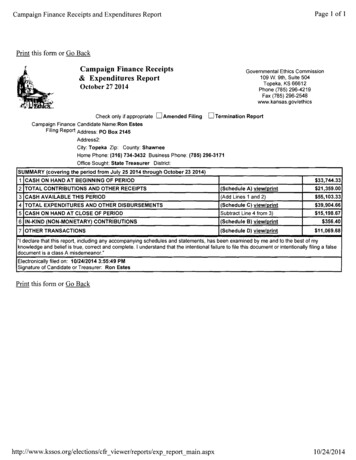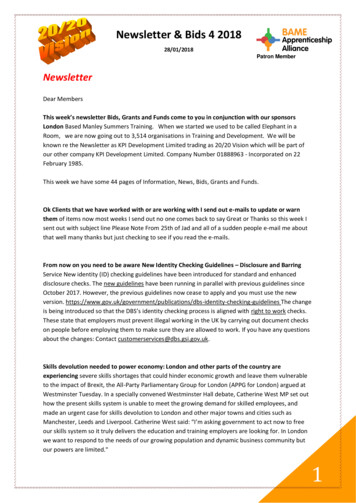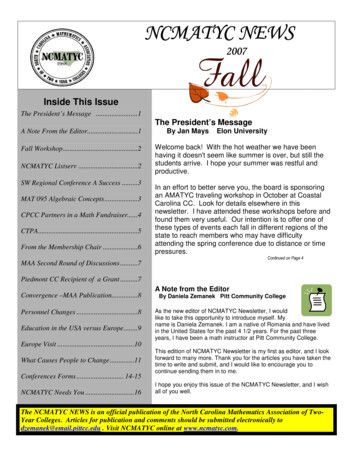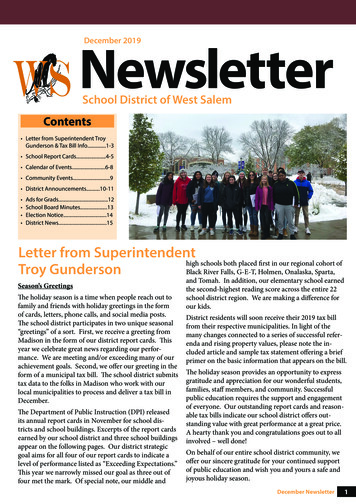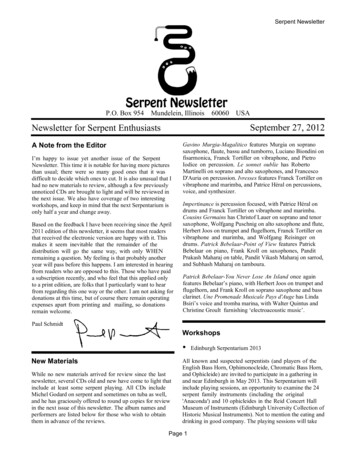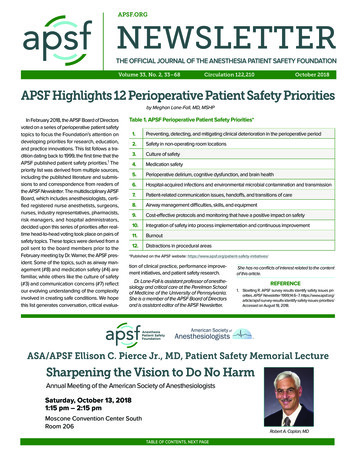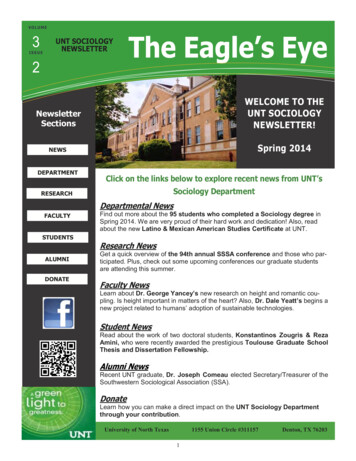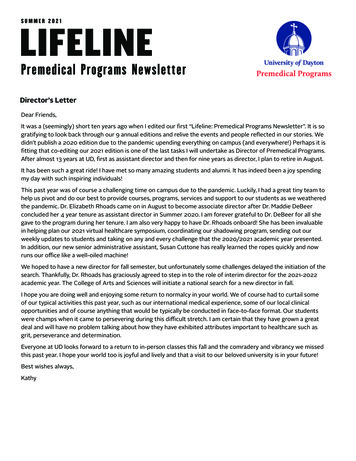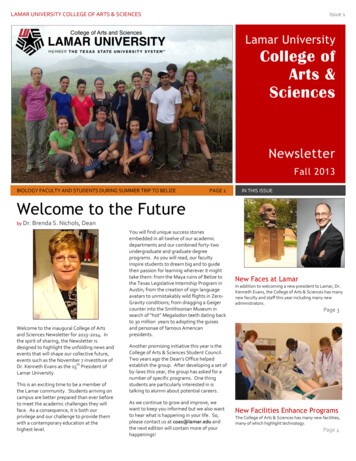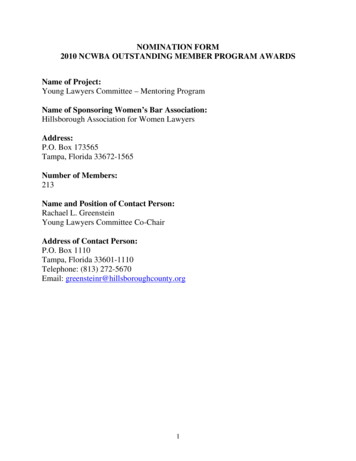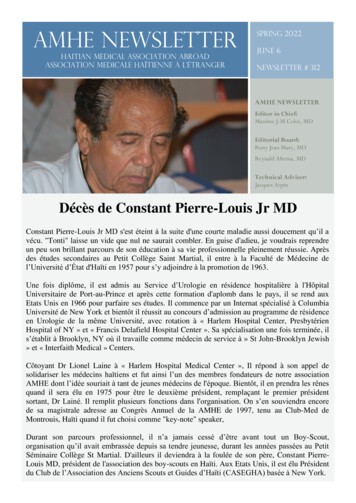
Transcription
AMHE NewsletterHaitian Medical Association AbroadAssociation Medicale Haïtienne à l'Étrangerspring 2022june 6Newsletter # 312AMHE NEWSLETTEREditor in Chief:Maxime J-M Coles, MDEditorial Board:Rony Jean Mary, MDReynald Altema, MDTechnical Adviser:Jacques ArpinDécès de Constant Pierre-Louis Jr MDConstant Pierre-Louis Jr MD s'est éteint à la suite d'une courte maladie aussi doucement qu’il avécu. "Tonti" laisse un vide que nul ne saurait combler. En guise d'adieu, je voudrais reprendreun peu son brillant parcours de son éducation à sa vie professionnelle pleinement réussie. Aprèsdes études secondaires au Petit Collège Saint Martial, il entre à la Faculté de Médecine del’Université d’État d'Haïti en 1957 pour s’y adjoindre à la promotion de 1963.Une fois diplôme, il est admis au Service d’Urologie en résidence hospitalière à l'HôpitalUniversitaire de Port-au-Prince et après cette formation d'aplomb dans le pays, il se rend auxEtats Unis en 1966 pour parfaire ses études. Il commence par un Internat spécialisé à ColumbiaUniversité de New York et bientôt il réussit au concours d’admission au programme de résidenceen Urologie de la même Université, avec rotation à « Harlem Hospital Center, PresbytérienHospital of NY » et « Francis Delafield Hospital Center ». Sa spécialisation une fois terminée, ils’établit à Brooklyn, NY où il travaille comme médecin de service à » St John-Brooklyn Jewish» et « Interfaith Medical » Centers.Côtoyant Dr Lionel Laine à « Harlem Hospital Medical Center », Il répond à son appel desolidariser les médecins haïtiens et fut ainsi l’un des membres fondateurs de notre associationAMHE dont l’idée souriait à tant de jeunes médecins de l'époque. Bientôt, il en prendra les rênesquand il sera élu en 1975 pour être le deuxième président, remplaçant le premier présidentsortant, Dr Lainé. Il remplit plusieurs fonctions dans l'organisation. On s’en souviendra encorede sa magistrale adresse au Congrès Annuel de la AMHE de 1997, tenu au Club-Med deMontrouis, Haïti quand il fut choisi comme "key-note" speaker,Durant son parcours professionnel, il n’a jamais cessé d’être avant tout un Boy-Scout,organisation qu’il avait embrassée depuis sa tendre jeunesse, durant les années passées au PetitSéminaire Collège St Martial. D'ailleurs il deviendra à la foulée de son père, Constant PierreLouis MD, président de l'association des boy-scouts en Haïti. Aux Etats Unis, il est élu Présidentdu Club de l’Association des Anciens Scouts et Guides d’Haïti (CASEGHA) basée à New York.
2Il choisit Jeany Gentillon MD, anesthésiologiste pourfonder sa famille et a eu d’elle trois jolies filles qui ontpleinement réussies dans leur vie professionnelle,Marilyn et Caroline qui sont présentement médecinsavec spécialité respectivement en Hématologie et enMédecine Interne, et Pascale qui a choisi la pédagogie.Je saisis l'occasion pour exprimer tant en mon nompersonnel qu'en celui de l'Association MédicaleHaitienne à l'Etranger nos sincères condoléances àJeany sa femme, à ses enfants Marilyn, Caroline,Pascale et leurs familles, aux familles et amis prochesaffectes par son départ. Sa mission sur terre estterminée. Que ce Dieu de Miséricorde le reçoive à brasouverts dans sa nouvelle demeure et que la terre luisoit légère. Ce n’est qu’un au-revoir, "Tonti".Les arrangements pour les services de funérailles et decélébration de sa vie, dès que dévoilée par la famille, vous seront communiqués ici.Maxime Coles MDDr Emanuel Arnoux, Dr Frantz Douyon, Colonel FADH réformé Williams Avin, Dr Raoul Brisson, Dr Constant PierreLouis (Tonti ), Ingénieur Jacques Blanchard, Dr Jean Claude Victor, Dr Jules Henri et l’Ingénieur José Dalencour.
3Eulogie pour le DocteurConstant Pierre Louis fils, dit Tonti.Le docteur Constant Pierre Louis fils, Tonti, nous a laissé, sans bruit sans compte,comme il a vécu, le vendredi 20 mai 2022 pour le pays sans chapeau, comme on dit cheznous.Mon amitié avec Tonti a débuté à la fin des années 50 à l’adolescence. Nous avons étudiéensemble pour les examens de Rétho, les examens de Philo et pour l’admission à l’écolede médecine. Nous avons cheminé ensemble à la faculté et avons été reçu le même jourDocteur en médecine. Notre amitié s’est poursuivie et s’est raffermie au cours de cedernier demi-siècle, sans bruit sans compte. Tonti est le parrain de mon deuxième fils.À l’époque de son adolescence Tonti se définissait souvent comme le gros sympathique.C’était ça Tonti. Il n’était pas conflictuel, il n’antagonisait personne, chacun se sentaitconfortable en sa présence calme et conciliante. Il cultivait ses amitiés, toujours prêt àécouter, à conseiller et à encourager. Il faisait ouverture partout. Quand en 1975,l’AMHE eut à traverser une crise d’adolescence à l’occasion d’une élection, on fit appelà Tonti. Il ne se déroba pas. Il prit la direction de l’association, sans bruit sans compte. Ilpermit au temps de calmer les esprits pour permettre à l’AMHE d’atteindre une maturitéet de se placer dans la bonne direction. Nous devons à la sagacité de Tonti d’avoir uneassociation qui existe encore jusqu’à présent, avec un changement de garde réussi.Après sa graduation en médecine, Tonti ira, comme résident, rejoindre son père, alorschef du service d’Urologie de l’Hôpital général, le docteur Constant Pierre Louis père,Gros Citron, comme l’appelaient affectueusement les Internes et les Résidents del’hôpital général.Malgré l’éloignement géographique en diaspora, Tonti aux États-Unis et moi au Canada,nos contacts téléphoniques étaient fréquents, souvent très longs. Nous échangions surtout. De plus, pendant près de dix ans, notre groupe d’amis, y compris Tontinaturellement, avait pris l’habitude de se réunir chaque été au Canada, dans la campagnequébécoise. La première année la réunion a duré une fin de semaine, mais très vite nousavons décidé de la prolonger pour en faire un évènement annuel qui durait toute unesemaine. Nos amis faisaient exprès le voyage d’Haïti, des États-Unis, du Canada pour nepas manquer ce rendez-vous de l’amitié. Il nous est arrivé d’être au complet, un groupede neuf, amis d’enfance et d’adolescence, anciens condisciples de classe devenus adultes,de différentes disciples, mais tous animés par les mêmes valeurs. Ancien militaire haitien
4réformé, ingénieurs, médecins, nous venions participer à cette rencontre annuelle deressourcement amical. Les journées commençaient tôt le matin et finissaient souventtrès tard le soir. Tonti y était toujours. Il jouait souvent le rôle de modérateur ou demaitre de cérémonie improvisé dans nos échanges multiples, bonnes humeurs, parfoistrès animés. C’était le bon vieux temps! Nous étions alors relativement jeunes. Avec letemps nous avons pris de l’âge et des problèmes de santé de chacun allaient mettre unefin prématurée à ces rencontres dont nous gardons un agréable et impérissable souvenirimmortalisé dans des photos nostalgiques. Tonti devient aujourd’hui le quatrième amidu groupe à partir, sans bruit, sans compte.Un soir, en Haïti, Tonti et moi nous étions à Port-au-Prince au club mondainCamaraderie, quand Tonti fut terrassé par un coup de foudre pour une ravissante jeunefille, et ce fut pour la vie ! Sans bruit sans compte, ils se marièrent. C’était au siècledernier, il n’y avait pas encore d’ordinateur, ni de téléphone intelligent. On apprenaitencore par cœur les tables de multiplication.Ayant terminé sa résidence en Urologie en Haïti, le couple Tonti et sa femme Jeannie serendent à New York pour continuer leur spécialisation, lui en Urologie, elle enAnesthésie. Après une vie professionnelle bien remplie, sans bruit sans compte, lecouple Tonti/Jeannie se résigneront à une retraite bien méritée. La santé de Tonticommençait aussi à baisser lentement.Plus de cinquante ans plus tard, trois enfantset sept petits-enfants, voilà qu’aujourd’hui lerideau tombe. Tonti tire la révérence.Mission accomplie, sans bruit sans compte.Quand un Mapou tombe, c’est toute la forêtqui pleure. Nous en sommes là, sans bruitsans compte, comme Tonti l’a voulu.En mon nom personnel, au nom de notregroupe d’amis, au nom de l’AMHE, jeprésente à la famille nos sincèrescondoléances.Dr Frantz Douyon
5Requiem pour Tonti Constant Pierre-Louis Jr MDTonti est mort!A cette nouvelle on se rend compte, une fois de plus que les larmes aux yeux ont unefonction. Et ceci spontanément.Tonti était certes au départ le grand-frère d’un camarade de promotion en classessecondaires, notre ami Bicolo, et plus tard l’idole d’une fratrie beaucoup plus largecomprenant plusieurs générations de Médecins.On veut éviter, en cette occasion bien pénible de ressasser les vieux clichés et rediresimplement notre affection spontanée et sincère. Finalement, ce n’est pas pour rien que dansune famille, on se surnomme Tonti, Bicolo, Ti-Jean etc .Tonti était immense! Il y avait beaucoup dans ce modèle, (au risque d’accumuler dessynonymes) : intégrité, rectitude , droiture, scoutisme, vivacité d’esprit, sens du devoir,éloquence, camaraderie et surtout patriotisme transcendantal, sans coterie ni cosmétiqueidéologique.C’est pourquoi en Faculté et à l’ Association Médicale (AMHE) dès sa fondation,personnellement , je le suivais. Et en ainé responsable, il me suivait également, à la manièred’un Jésuite laïque, d’un « doigt invisible », et d’un « oeil-visonnaire » . Le tout ponctué dephrases très courtes qui vous indiquaient tout de suite la bonne ou la mauvaise direction.Il existe finalement un lien important entre Tonti et notre promotion de Médecine, par lebiais d’une grande dame, Jeany Jentillon Pierre-Louis M.D., épouse de Tonti, cette collègueCatherine qui nous réunit. En langage d’initiés nous parlerons de tissu conjonctif.Sincères condoléances à Jeany, Bicoloet la grande famille.Tonti la kwaOu devanNou dèyè.Déro.Mai 2022Dr Roger Derosena
6
7Link for The Funeral Mass for Dr. Constant hNécrologie de Constant Pierre-LouisVoici la nécrologie de Constant Pierre-Louis. Veuillez accepter les sincères condoléances d'Echovita.Il est toujours difficile de dire au revoir à quelqu'un que nous aimons et chérissons. La famille et lesamis doivent dire au revoir à leur bien-aimé Constant Pierre-Louis de Jamaïque, New York, décédé àl'âge de 83 ans, le 20 mai 2022. Vous pouvez envoyer votre sympathie dans le livre d'or fourni et lepartager avec la famille. Vous pouvez également allumer une bougie en l'honneur de Constant PierreLouis ou envoyer un bel arrangement de fleurs au service funéraire.Il était aimé et chéri par de nombreuses personnes, dont : son époux Jeany Pierre-Louis ; ses enfants,Marylin Pierre-LouIS, Pascale Gabriel (Jonathan) et Caroline Cromwell (Brian) ; ses petits-enfants,Brian Cromwell Jr., JP Woodham, Jonathan Gabriel Jr. , Ella Cromwell, Patrick Woodham, JordanGabriel et Joseph Gabriel ; et ses frères et sœurs, Gerard Pierre-Louis, Edouard Pierre-Louis,Jacques-Pierre-Louis , Jean Pierre Louis et Phillipe Pierre-louis.Une messe funéraire aura lieu le samedi 4 juin 2022 à l'église Immaculée Conception RC (86-43Edgerton Blvd, Jamaïque, NY 11432).Ceux qui nous ont quittés ont marqué leur temps et ils vivent parmi nous.Hommage à ceux qui nous tracent le chemin.Maxime Coles MDCliquer sur les photos pour voir les albums
8Note de l’Editeur en ChefMaxime Coles MDAMHE Newsletter publie dans cette nouvelle edition, sahuitieme Vignette de la serie intitulee, “In The Biginning”relatant sur la creation des differents chapitres de notreassociation. Nous laisserons au Docteur Ducamel Augustin lesoin de nous faire un rappel sur l’etat d’esprit des membres dela AMHE dans le Sud de la Floride.Je m’en voudrais de ne pas presenter formellement Docteur Ducarmel Augustin.Ducarmel fait ses etudes primaires, secondaires et collegiales chez les freres del’instruction Chretienne (St Louis de Gonzague). Il s’inscrit a la Facute de Medecine etde Pharmacie et fait partie de la promotion de 1972.Apres ses etudes medicales dans l’Alma Mater, il fait une residence hospitaliere al’hopital General (HUEH) dans le service du Dr Frantz Medard. Nous l’avons bienconnu alors que nous faisions nos rotations. Il etait jovial et s’imposait aux plus jeunes.Une fois diplome, il se rend aux Etats Unis pour parfaire ses etudes. D’abord il estaccepte en Medecine Interne pour un “Rotatory intership” a Homer G Hospital dans laville de St Louis (MO). Ensuite, il decide de se rendre a Montreal PQ, Canada pourbriguer une residence en Medecine Interne. Il entame aussi une specialization enmaladies gastro intestinales. Finalement, il choisit d’etablir une pratique privee enMedecine Interne dans l’etat de la Floride.C’est donc, dans ces circonstances qu’il assumera les fonctions de President du chapitredu Sud de la Floride et plus tard, celle de Chair-person de la AMHE (Board ofThrustees).Nous lui devons une fiere chandelle d’avoir pu compiler les differents episodes qui ontmarque la venue de la AMHE sans le monde medical floridien. Je profite de l’occasionpour remercier les docteurs Jules Andre Cadet et Ernst Moise qui ont aussi participeavec Ducarmel a la redaction de ce texte. C’est avec un immense plaisir que, sans plustarder, je l’invite a nous entretenir sur la naissance des chapitres de la AMHE dans leSud de la Floride.Maxime J-M Coles MDEditeur-en-chef
9AMHEIn the beginningFrom 1981 to 1988 .The story of Florida inside AMHEand the birth of the South Florida ChapterDucarmel Augustin, MD
102- Chapitre de Floride en 1985C’est donc dans ce contexte qu’est né le chapitre de Floride en 1985 , présidé par Dr. Paul Henrys. Cependantson existence sera de courte durée.Donc il y eut 2 chapitres à Miami en 1985-1986! Une première pour l’association !Ces 2 chapitres ont cependant cessé de fonctionner et d’exister en 1986, et ce malgré le “ fact finding mission“ et les multiples interventions louables des ténors du Comité Exécutif Central de l’ Association d’alors présidëpar docteur Marie Claude Rigaud.De 1986 a 1988 il y eut un long hiatus , C’était un grand vide.1987 voit l’arrivée en Floride venant de Montréal du docteur Ducarmel Augustin . Voulant continuer àparticiper à la vie de l’association , il a contacté des confrères dont Joseph Fanfan Jr. et Jean ClaudeDesgranges qui l’ont informé qu’il n’y avait d’ activités de chapitres à Miami 3- Chapitre de Broward-Palm Beach / Chapitre du Sud de la Floride en 1988Il y a 34 ans le 3 juillet 1988 au cours d’un “Independance Day picnic “ au Quiet Waters Park deDeerfield beach , les docteurs Ernst Moise et Joseph Fanfan ont endossé l’idée de la naissance d’unnouveau chapitre en Floride ( Broward ) et le samedi 28 août 1988, le coordonateur du Comité Ad hocDr Ducarmel Augustin convoque une Réunion chez Dr Ernst Moise à Coral Springs pour présenter leprojet du nouveau chapitre à la trentaine de médecins invités.Les articles constitutifs du Chapitre de Broward-Palm Beach sont votés et ainsi a vu le jour le Chapitre deBroward - Palm Beach de l’ AMHELe Samedi 19 novembre 1988 s’est tenue la première assemblée générale des membres au Fort LauderdaleHilton Airport sur Griffin Road . Des collègues de Miami avaient été également invités. On était près d’unecinquantaine Dr. Joël Henriquez Poliard s’est levé et a eu le mâle courage de demander un changement denom parce que Dade county Miami voulait se joindre aux comtés de Broward et Palm BeachLe coordonateur a proposé le changement de nom en South Florida Chapter de l’AMHE ce qui a été voté par acclamationLe premier Comité exécutif du chapitre est forné des docteurs Ernst Moise (président), Joseph Fanfan jr (1erVice President), Louis B. Antoine (2e Vice President) Ducarmel Augustin (secrétaire), Yves Jodesty (assistantsecretaire), les docteurs Jaques A Victor et Jacques H Guiteau à la trésorerie.La Floride est aussi le seul état à compter 2 chapitres actifs :The South Florida chapter basé à Fort Lauderdale et The Orlando chapter qui regroupe les medecins du centrede la Floride depuis l’année 2019Je remercie infiniment tous les collègues, spécialement les docteurs Jules André Cadet et Ernst Moise qui ontspontanément répondu à notre appel et participé à leur façon à la rédaction de cette importante tranche d’histoire des chapitres de la Floride au sein de l’ Association des Médeçins Haitiens à l’ Etranger, rebaptiséeAssociation Médicale Haitienne à l’ Etranger lors du 45e Congrès Annuel tenu à Baru, Colombia en juillet2018 .Ducarmel Augustin,MD3 juin 2022Voir : AMHE ARCHIVE CHAPTER
11Cancer of PancreasMaxime Coles MDPancreatic cancer begins in the tissues of your pancreas, an organ thatlies behind the lower part of your stomach. The pancreas releasesdigestive enzymes and produces hormones that regulate the bloodsugar.Cancerous and non-cancerous tumors can be seen in this organ. Themost common form of malignant tumors arises from the cells lining theducts and generally carrying the pancreatic enzymes: The PancreaticDuctal Adenocarcinoma. They are seldom detected at an earlier stagewhich would render them more curable. Unfortunately, when they aregenerally discovered, they have already spread to other organs leavinglittle chances for a successful treatment.The pancreas lays behind the lower aspectof the stomach between the aorta and someof its main tributary branches. It has theshape of a fish carrying three main parts: awide head, a tapering body with a pointedtail. In an adult, the size may vary up to 6inches (15 centimeters) in length andaround 2 inches (5 centimeters) in width.The head of the pancreas is located on theright side of the abdomen, behind thestomach and anchors the duodenum andthe first part of the small intestine. Thebody of the pancreas follow transversallyIn this number
12behind the stomach and the tail reaches the left side of the abdomen close to the spleen. The pancreaspossesses exocrine glands secreting the digestive enzymes and endocrine glands responsible for theproduction of Insulin (Beta cells) and Glucagon (alpha cells).Pancreatic tumors are relatively rare, representing 1.8% of all tumors in France according to a study donein 2011 and representing less than 10,000 cases discovered in the recent years. They are generallyneuroendocrine (exocrine) tumors) with the most common type called an adenocarcinoma. The incidenceappears to be on the rise.I would like to review some of the predisposing factors. In the United States of America, recently (2021),more than 60,000 cases were diagnosed with a 3.2% incidence on all new cancer, placing the disease asthe 11th most common cancer. More than 48,000 persons died from the disease at a medium age of 71.Incidence and mortality rate were studied in 2017 and a study showed it to be higher in men 14.9 thanwomen 11.6 with more Blacks 15.3% compared to Non-Hispanic Whites 13.1% and Hispanics. Thelowest rates were found in Asian and Pacific Islanders and American Indians and Alaska Natives.Black patients with pancreatic cancers are diagnosed generally at a younger age with often a moreadvanced disease. It will be noted that Black patients received less treatment stage-for-stage and fewersurgical resections than their White patient’s counterpart. This was attributed to the racial disparity andbiases among the healthcare professionals.Many risks factors have been identified especially to Cigarette smoking, Obesity, Consummation of redmeat (Nitrites), Chronic Pancreatitis especially with the new onset of Diabetes and Hyperglycemia.Periodontal diseases have also played a role. Let us review some of these associations:Cigarette smokers were found to have twice the risk for pancreatic cancers compared to the non-smokers.The more cigarettes one smokes, the higher chances he/she will have to develop cancer of pancreas whilethe risks are diminished with rescission of smoking after 15 years. There is also a relation between theamount of cigarette smoke and the duration of the exposition with the rate of cancer. In the USA, up to30% of death due to pancreatic cancer are directly attributable to cigarette smoking. There are limitedevidence suggesting that alcohol consumption is associated to an increase rate of cancer of the pancreas.The combination of smoking and drinking has not been proven to be a factor either while the heavyconsumption of liqueur has shown a strong assimilation with the rate of tumors.Obesity with a body mass (BMI 30) during early adulthood is associated with a higher incidence inpancreatic cancers. This is why Obesity is associated to up to 40% of mortality in the disease. Visceralobesity has also a strong correlation to metabolic syndrome, insulin resistance and gastrointestinalmalignancies. Familial forms also exist, explaining around 5% of the cases. Mutations exist on certaingenes like BRCA2, ATM, PALB2 which would favorize the pancreatic tumors.There is some evidence that diet can play as well a role. The high consumption of red meat was found tobe associated to a higher cancer risk while Coffee or Tea did not show this tendency. There is a linkbetween Vitamin D and pancreatic cancer. Other suggest that a low level of 25-hydroxyvitamin D levelscan increase the risks. We have mentioned periodontal diseases and chronic pancreatitis in their roleswith the seeding of bacterial components and the inflammatory mediators contributing to thedevelopment of digestive cancers. 5% of patients with chronic pancreatitis will develop pancreaticcancers. If the pancreatitis is associated to hereditary factors, the risk of cancer will increase up to 50-foldto a cumulative age of 70.Pancreatic cancer has a complex relationship to Diabetes and over the years, this relation is becomingbetter understood. Noted since 1933 and studied at the Mayo Clinic in the late 1950’s, it is well admitted
13that patients with Type I or type II diabetes have an associated risk in developing cancer of the pancreaswith a 7-10-fold greater risk based also on the level of the Hemoglobin A1C. Insulin use has also beenassociated with a higher rate of pancreatic cancer. Other studies have identified new onset diabetes,pancreatitis in diabetics etc to be determinant risk factors. Further studies are needed to put at rest,debates relating to pancreatic cancer and Diabetes Mellitus.Pancreatic tumors are caused by somatic (acquired) and germline (inherited) mutations in specific cancerassociated genes. The combination of gene mutations significantly perturbs major signaling pathways,leading to a malignant phenotype. These mutations disrupt intra and extracellular network that restrainabnormal growth, survival etc. Many genetic drivers are fundamental, involving mutational activation ofthe oncogene KRAS and mutational inactivation of the tumor suppressing genes TP53 as well as theinactivation of the genome maintenance gene that repair DNA damage etc. With a low populationincidence 1.3% and the absence of biomarker screening target, sensitive imaging methods are used toprevent and detect pancreatic cancer in asymptomatic adults since 2019. In Australia, the publicawareness campaigns have encouraged individuals to look for medical advices earlier. Signs like backpain, lethargy, new onset of Diabetes are used in the population. Even neuropsychiatric signs can beassociated to these tumors.Remember that the pancreas carries exocrine glands secreting digestive enzymes but has also a glandularportion (endocrine) with the role of secreting hormones synthetized and released into the pancreaticcanal. It is believed that this is where the gland is more often vulnerable to the formation ofadenocarcinomas. Some believes that this part can be involved more than 20 times often than theexocrine part. The endocrine portion can also produce other kind of tumors like ampullomas andcystadenocacinomas.Between one and 10 cases per 100,000 / person are discovered with more than 279 thousand dying fromthis cancer and compared to other cancer like larynx which have regressed. Two men for one woman arepresenting with signs of pancreas cancer at the age of 70 appear to be the norm for such cancer. Men arealmost twice more often victim of such cancer with 7.7 men to 4.7 women but the numbers increase pastthe age 50. In 2010, 10,200 cases of cancer pancreas were discovered in France, a 3% of all cancers and a10% of all digestive cancers. But the mortality rate remained unchanged after 50 years old. Some patientswere able to benefit from an operation but the complication rate was important because it remains onecancer with the lower chances of survival (5% for a 5 years). The mortality rate increases with ageespecially among women.The symptomatology varies with the site of the pancreatic tumor. The lesion is in the head of thepancreas in almost 75% of the cases, creating an obstacle to the normal drainage of the biliary tract. Anobstruction at this level may force a block to the natural drainage of the bile through the choledochalcanal. The obstacle will create a rapid dilatation of the gallbladder creating a reflux of bile. Patient willdevelop icterus and pruritus, diarrhea and steatorrhea etc. If the lesion is in th body or in the tail of thepancreas (25%), the patient will suffer more with abdominal cramps, retroperitoneal pain and a mass canbe palpated in the epigastrium. Most of these tumors will directly invade the surrounding visceral organs.An irregular enlargement of the liver may be appreciated because of hepatic metastasis and the presenceof ascites carry a poor prognosis. Anorexia, vomiting, cachexia will follow. A progressive destruction ofthe pancreas will result in a non-functioning endocrine and exocrine gland forcing a state of malnutritionand a late onset of Diabetes Mellitus.By the time the diagnosis is made, most patients (85-90%) have already an involvement of the intraperitoneal structures and an involvement of the lymph nodes. If a cancer syndrome is identified at-riskrelative should be offered genetic counselling. People with family history of pancreatic cancer especiallythe young with symptoms, people with Ashkenazi Jewish ancestry, people with BRACA1 or BRACHA2,Peutz-Jeghers, Cystic fibrosis, Familial Pancreatic cancer, Li-Fraumeni etc.
14How to diagnose a cancer of the pancreas.?. It is certainly possible to diagnose a patient with pancreaticcancer based on symptoms and signs only. Abdominal Imaging is used in the diagnosis and staging of thework-up. An accurate diagnosis carries the best chances for an appropriate recommendation and a mostsuitable treatment. The accuracy critically depends on the appropriate imaging protocol and theradiologist experience in reading CT-Scans. A biopsy can be done through the skin (transcutaneous) orduring a laparotomy or at a laparoscopic procedure. Often the diagnosis rests on a biopsy of thepancreatic tissue or on the tissue taken from a metastasis or even through an endoscopy via theduodenum. Laboratory study looking markers from the mesothelium can suggest such diagnosis but theproteins are also secreted by ovarian tumors. In 2017, it was reported that two biomarkers werediscovered the thromboapondine -2 (THBS2) et le CA 19.9. Other biomarkers have suggested an earlydetection of this adenocarcinomaAbove : CT-Scan with a contrast dye material is the examination of choice to evaluate any localextension of an adenocarcinoma du pancreas. The above picture is the representation of such a mass inthe head of the pancreas.The C-Scan with contrast material romains the best study to evaluate and diagnose a mass in the pancréasand to appreciate the size and the local extension of a tumor. It can allow the discovery of métastasesthrough other organs of the abdomen.as well as the lymph nodes involvement. The position of such massor metastasis in relation to the portal vein is essential and may represent signs of operability.Multidirector Computed Tomography (MDCT) with IV contrast is the preferred imaging study for initialevaluation of a suspected Pancreatic Adenocarcinoma. This test was found to be accurate in 77% of casespredicting resectability and 93% accurate in predicting unresectability for any tumor larger than 1.5centimeter in size.« Magnetic Resonance Imaging Resonance-Cholangiopancreatography » (MRI/MRCP) employs IVcontrast to detect almost 100% of liver metastases. « Endoscopic Retrograde Cholangiopancreatography« (ERCP) is performed by injecting contrast dye into the biliary and pancreatic ducts through anendoscope in order to determine the level of obstruction.The precise location of the blocage will suggesthow to relieve symptoms of jaundice. Often this procedure is done first.
15« Transabdominal Ultrsonography « is useful on patients presenting signs of obstruction. It can be evensuperior to MDCT. Ecchography is also an other way to look for pancreatic tumors with less sensibilitythan the CT Scan. In other hands, « Endoscopy" has played a major role allowing the introduction of atube into the duodenum to enter the pancreatic canal, and perform an injection of contrast material. Thisis called a « cholangiopancreatography ». Any narrowing of the canal or mass of any size, can bedetected as well. More, a biopsy can be performed if desired. « Endoscopic ultrsonography » is alsovaluable in detecting tumor involvement of blood vessels or lymph nodes.« Positron-Emission Tpmopgraphy » (PET) imaging alone does not offer added advantages to MDCT butin combining a PET scan with a CT scan (PET/CT), a new combination that may enhance the detectionof occult metastases in pancreatic tumors.A positive « Biopsy » is not needed when a patient with a resectable lesion is undergoing surgicaltreatment because it may occasion seeding of the material in the peritoneal cavity and interfering with thedefinitive surgical treatment. The confirmation of the pancreatic lesions or their metastases is alwaysrequired and can also be obtained via endoscopic ultrasonographic guided biopsy. Such pathologicdiagnosis is indicated to
AMHE Newsletter Haitian Medical Association Abroad Association Medicale Haïtienne à l'Étranger AMHE NEWSLETTER Editor in Chief: Maxime J-M Coles, MD
